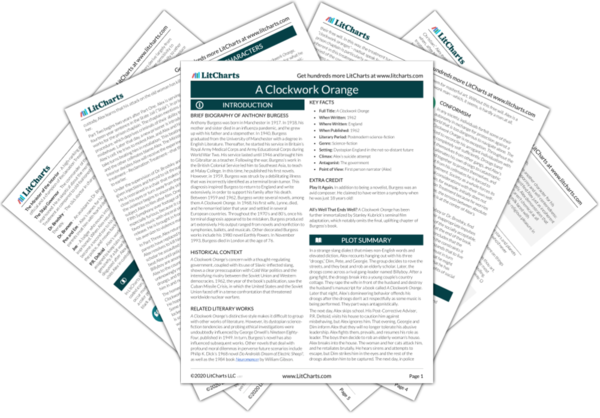Language
A Clockwork Orange’s ingenious use of language is one of the book’s defining characteristics. Beginning with the novel’s arresting opening, readers are inundated with “nadsat” slang, the part-Cockney, part-Russian patois Alex uses to narrate the story. Alex’s language, like the novel as a whole, is a chaotic amalgam of high and low. Just as the plot juxtaposes grotesque violence with poignant art, Alex melds disparate linguistic influences in his narration: nadsat jargon mingles with…
read analysis of LanguageSadism and Society
Another of the work’s stylistic trademarks is its frequent and graphic depiction of violence. In the first chapters of the book, Alex savagely beats a doddering scholar, rapes women and girls, and murders an elderly shut-in. But although Alex stands out as a merciless sadist in the earlier part of the work, later events reveal that other members of his society are also capable of similar behavior. The doctors who administer gruesome films to Alex…
read analysis of Sadism and SocietyFree Will vs. the “Clockwork Orange”
The title of the novel is an allusion to its central ethical dilemma. The phrase “A Clockwork Orange” appears within the book as the name of F. Alexander’s polemic against Reclamation Treatment, the state-sponsored aversion therapy that Alex undergoes. Reclamation Treatment renders criminals unable to think about violence without experiencing extreme pain themselves, thus removing a significant amount of their free will. In this way, the treatment turns individuals into “clockwork oranges”—nadsat speak for “clockwork…
read analysis of Free Will vs. the “Clockwork Orange”
Art and Humanity
Burgess’s malevolent protagonist is humanized, somewhat, by his reverent appreciation for the fine arts. Even though Alex is a bloodthirsty sociopath and a public menace, he is not utterly nihilistic. The sound of his favorite classical music seems to induce a more humane, respectful temperament in him. For example, when Dim behaves boorishly in a diner while a girl sings nearby, Alex punches him and reprimands him harshly. This altercation precipitates the droogs’ betrayal of…
read analysis of Art and HumanityConformism
In any society, individuals forfeit some of their autonomy in exchange for protection against a world that is too dangerous to navigate alone. The universe of A Clockwork Orange is no exception. Throughout the book, Alex is forced to reconcile his arrogant individualism with his inability to live completely self-sufficiently. Droogs band together to protect themselves from other gangs, and Alex's selfish individualism alienates his own droogs to catastrophic results. Prisoners band together to protect…
read analysis of Conformism











